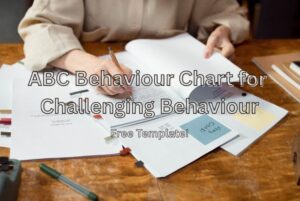
No one finds it easy to cope with challenging behaviour—be it from a student as a teacher or from a child as a caregiver. These difficult behaviours often create a lot of confusion and concern, and trying to find an appropriate solution seems impossible at times. This is where the ABC Behaviour Chart comes in—it is a tool that helps create order from chaos through structured observation and analysis.
If all you need is an effective and simple method of monitoring and responding to challenging behaviour, this blog will walk you through:
- The ABC chart method
- How this method works in real life
- The why and when this tool is most effective
- Tips and tricks for effective usage
- A free ABC chart template to get you started
Let’s see together how this simple tool can help you change the way you respond to and understand behaviours.
What Is the ABC Chart?
An ABC Chart can be described as a systematically designed observational tool used to identify patterns in behaviour. The letters in “ABC” designate the following:
- A – Acronym Antecedent (What happened prior to the behaviour)
- B – Behaviour (What is the specific action being performed)
- C – Consequence (What transpired subsequent to said behaviour)
The chart aids in understanding the triggers, the behaviour itself, and what strengthens or weakens it by dividing behaviour into these three components. Having this knowledge is important for managing incidents and providing the right support for the individual.
Who Can Benefit From the ABC Behaviour Chart?
The ABC Chart is well-tailored for various users, including:
- Schools (especially for pupils with SEND or behavioural difficulties)
- Special educational needs (SEN) settings
- SEN care homes and supported living environments
- Therapeutic settings (Speech therapy, Occupational therapy, Psychology)
- At home of parents and guardians dealing with challenging children
- Healthcare spaces, especially those related to mental health or learning disability support
Regardless of your standing, parent or professional, the ABC Chart is a user-friendly tool based on scientific research that aids in understanding behaviour and custom-designing support approaches.
Complete Our Teaching and Child Care Courses - Essential for Anyone Who Works with Children!

Understanding Each Element of the ABC Chart
🟩 A – Antecedent (What Happens Before the Behaviour)
This subsection tracks the event/prompt that occurs just before the behaviour. It attempts to clarify:
- What was taking place at that moment?
- Where was the individual at that time?
- Who else was in the vicinity?
- Was there any specific instruction, demand, or shift in the environment?
Examples of antecedents:
- The teacher instructed the student to commence writing.
- A commotion was heard in the hallway.
- Another student took their toy.
- It was time for a change in activities.
🟨 B – Behaviour (What the Person Did)
This subsection captures the actions taken in a behavioural focus approach, that is, as objective, specific, and observable actions rather than interpretations or assumptions.
Examples of behaviour descriptions:
- A pupil threw a pencil across the room.
- Screamed and covered ears.
- A child hit a peer on the arm.
- A pupil ran out of the classroom.
- The student cried for five minutes.
Any action taken should be avoided from vague category labels like “was disruptive,” “acted out,” “wielder,” “threw things,” “was inappropriately physical.”
🟥 C – Consequence (What Happens After the Behaviour)
This includes any immediate reaction/reinforcer that happens after the action. What did people do? What happened afterwards?
As in the most usual case, consequences may, albeit unintentionally, reinforce behaviour; this is the reason why space is important to identify patterns.
Examples of consequences:
- The pupil was sent out of the class.
- The staff member permitted a break for them.
- Peers joined in the laughter and directed attention to them.
- The task was stripped away from them.
- They were left alone for a couple of minutes.

Why Use ABC Charts for Challenging Behaviour?
Most challenging behaviour is a way to communicate what the individual is feeling—especially if the individual has difficulties with verbally expressing themselves. The ABC chart reveals the unspoken behaviour by determining:
- An avoidable or modifiable course (trigger)
- Disregarded mitigation measures which reinforce negative behaviour (response)
- Cancellation for positive behaviour (alternative)
- Patterns for environmental/emotional cycles (e.g. time, noise, transitions)
Using an ABC Chart on a regular basis helps you avoid assumptions and support decisions based on data.
When to Use an ABC Behaviour Chart
Apply an ABC Chart when:
- Challenging behaviour is repetitive or on the rise.
- You wish to study specific incidents.
- You are developing a behaviour support plan.
- You are working multidisciplinary (teachers, SENCO, therapists, parents)
Using the chart more consistently makes it easier to track meaningful trends and make effective changes.

How to Use an ABC Behaviour Chart Effectively
1. Be Consistent
Make use of the chart right away or shortly after an incident to ensure the details are still fresh. Consistency across time and setting enhances the quality of insights.
2. Achieve Through Listing Objectives
Provide as much detail as possible when describing behaviour, refraining from subjective feelings or fuzzy terminology like “tantrums” or “acting out.” Focus on what was observed.
3. Add Context
Context includes time, place, specific setting and participants. Often, certain people or environments unlock certain behaviours.
4. Look Over An Extended Period
One specific entry might not stand out, but multiple over a short period will show the same patterns.
5. Collect Together
The chart works best as a collective document; the more people who give their input, including teachers, support staff, parents or guardians, the more complete the picture will become.
6. Use Alongside Other Tools
ABCs work well together with the following:
- Behavior trackers
- Emotion dysregulation logs
- Functional Behavior Assessments
- Behaviour Support Plans
Sample Entry Using the ABC Method
| Date & Time | Antecedent | Behaviour | Consequence |
| 12 Mar, 10:45 am | Teacher asked Sam to put away his toy and start reading | Sam threw the toy and shouted “No!” | Teacher removed toy and gave Sam a 5-minute break from task |
From analyzing the available information, we can reasonably conclude that the effort involved in a task will trigger child refusal, and withdrawal reinforces the refusal, even if passively. This assists a lot in changing methods toward proactive—such as using transition cues.

Patterns in Behavior that are Easily Recognizable
- Escape/Avoidance: The behaviour helps someone avoid an unwanted consequence (e.g. work, noise, transitions).
- Attention-Seeking: The behaviour is likely to have resulted in some form of attention (positive or negative) from an adult or peer.
- Sensory Needs: The behaviour satisfies sensory needs (e.g. hand flapping, noise-making).
- Frustration/Anxiety: The behaviour is an attempt to cope with emotional overload, misinterpretation, or lack of adequate communication.
Determining the function of the behaviour is the first and most important step in creating effective plans.
ABC Chart Template Download for Free
To assist you in tracking behaviours, we designed an ABC chart template you can download, print, and use daily.
The template comes with:
- Date & Time
- Name/Initials
- Antecedent, Behavior, and Consequence sections
- Space for notes, observations, or planned actions for follow-up
You can create multiple copies for use in classrooms, clinics, or homes or digitize it and use Google Forms, Excel, or Behavior Tracker Pro.

How ABC Charts Aid Intervention Strategy Design
- Patterns can be useful in tailoring interventions. For example, if the behaviour is triggered by transition anxiety, visual schedules or timers can be used.
- If avoidance is the reason, increase exposure to the task step by step and reward completion.
- If attention seeking, positively reinforce appropriate (and desired) behaviour and withdraw reinforcement following negative behaviours.
- This is by far more effective than responding to the action when there is no understanding of what the cause is.
Complete Our Teaching and Child Care Courses – Essential for Anyone Who Works with Children!
Last Reflections
There is hardly any behaviour that is odd for no particular reason. Every single action, mostly done by children, neurodiverse individuals, or those who are super non-verbal, always has a need, feeling, or a barrier attached. The ABC behaviour Chart is an accurate depiction of the thought process one may need to use when helping someone endure and overcome behavioural challenges.
⬅️ Major Considerable Notes:
- ABC refers to Antecedent, Behaviour, Consequence
- They can easily figure out the cycle of reinforcement, behaviour, and triggers.
- Consistent practice helps improve understanding and the appropriate response to be used.
- Developed encourages and supports collective answers to be used on the same issue.
- Free blank templates on the web foster and hasten the starting process.
- When there is the intention to observe, insight is bestowed, which allows change that counts.
